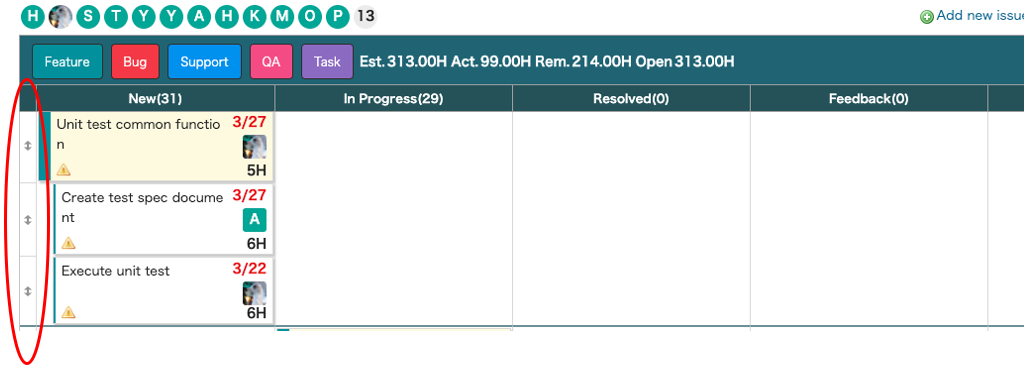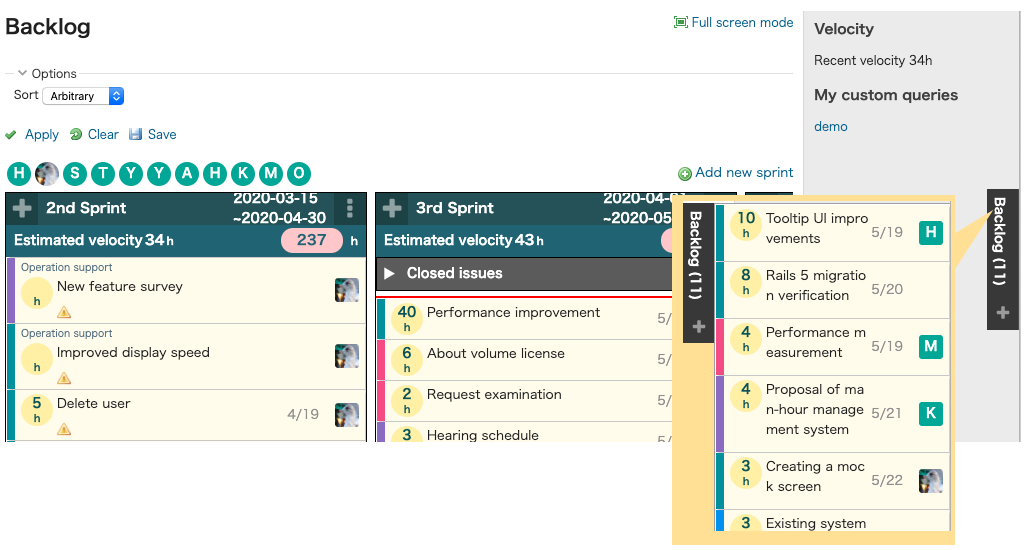❏ Setting Permissions
To use Lychee Kanban, you must first check the following boxes in the “Lychee Schedule Management (Kanban)” section under Administration > Roles and permissions.
- Kanban
- Backlog

❏ Project Settings
To display the Kanban tab, you must check the “Lychee Schedule Management (Lychee Kanban)” box under Projects > Settings > Project tab > Modules.

Setting Default filter
You can set which filter will be applied when initially displaying Lychee Kanban by going to “Default filter” on the Projects > Settings > Lychee Kanban tab.
The default filter is as follows.
The default filter setting differs depending on whether or not the project has saved versions.
| Versions | Filter |
|---|---|
| Yes | Target version = Set version |
| No | Start Date = This week |

❏ Setting Maximum number of items displayed on Lychee Kanban
You can set the “Maximum number of items displayed on Lychee Kanban” under Administration > Settings > Issue tracking.
Kanban will display issues up to the number you set here.
The default is “500”.

❏ Kanban Operations
Displaying Kanban
To display Kanban, click the Kanban tab under the Project menu.

a) Setting Users Displayed in Kanban
You can select the users/groups to be displayed in Kanban by going to the “Displayed Users/Groups” section on the Project > Settings > Lychee Kanban tab.

b) Displaying Estimated Time in Kanban
To display estimated time in Kanban, check the “Display estimated time in Kanban” box on the Project > Settings > Lychee Kanban tab.

Adding a New Issue
You can add a new issue by clicking “Add new issue”.
In the Kanban By Assignee, mousing over any cell will display a “+” icon. Clicking the icon will also allow you to add a new issue.
Additionally, if you set a version in the filter, that version will be used as the default value when adding a new issue.

Kanban Warning Icons
Kanban displays issue elements as below.

(1): Warning icons area
(2): Due date
(3): Estimated time
(4): Icon indicating a parent issue
(5): Parent issue’s name
■ List of warning icons
| Legend | Meaning |
|---|---|
 | Not started even though start date has passed |
 | Blocking turned ON |
 | Has preceding issue |
 | Has following issue |
 | Has preceding and following issues |
Editing an Issue
Clicking an issue in Kanban will cause a pop-up display to appear with the issue’s details.
Clicking the pencil icon in the top right of the pop-up window will allow you to edit the issue.

Setting Custom Fields Displayed in Issue Editing Form
You can select custom fields to be displayed in issues’ detailed information or editing forms by going to the “Custom field” section on the Projects > Settings > Lychee Kanban tab.

Adding a Child Issue
Clicking on the “+” icon on an issue will allow you to add a child issue for that issue.
The parent issue’s name will be displayed at the top of the child issue.



Full screen Mode
Clicking “Full screen mode” will display Kanban in full screen mode.
Clicking “Exit full screen mode” will return the screen to the normal view.

Custom Queries
Click on “Save” in order to create a custom query.

After being taken to the query creation screen, input the necessary information and click the “Save” button.

❏ Kanban By Priority
Issues are displayed by order of priority.
This view allows you to change the order of issues by dragging-and-dropping, and you can easily visualize the next issues to be started.
Sorting
You can change the order of the issues by changing the “Sort” under Options.
If “Backlog” is selected under “Sort”, you can drag-and-drop the ⇕ icon on the left of each row to change the issue order.
| Sort | Description |
|---|---|
| Backlog | Backlog order Order can be changed by dragging-and-dropping |
| Start Date | Increasing order by issue start date |
| DUe Date | Increasing order by issue due date |

You can drag an issue and drop it onto the desired status.
Changing an Issue’s Status


Changing Assignees with Gravatar Icons
If you have Gravatar icons enabled, you can change the assignee of an issue by dragging-and-dropping Gravatar icons.

To enable Gravatar icons, check the “Use Gravatar user icons” box on the Administration > Settings > Display tab.

❏ Kanban By Assignee
You can display issues by assignee.
This allows you to easily view the issues each assignee is about to start work on.
Changing an Issue’s Assignee or Status
You can change an issue’s assignee or status by dragging-and-dropping it on the desired assignee or status.

Displaying Unassigned Issues
Clicking on “Unassigned” on the right side of the screen will display issues which have not yet been assigned. You can assign them by dragging-and-dropping them on to members.

Displaying Estimated and Spent time
Under the “Display options” section on the Projects > Settings > Lychee Kanban tab, checking the “Display estimated time in Kanban” box will cause estimated and spent time to be displayed in the tracker header and in the Assignee column.

| Column | Description |
|---|---|
| Est | Total estimated time |
| Act. | Total spent time |
| Rem. | Remaining estimated time = estimated time – spent time (displayed in red if negative) |
| Open. | Total estimated time for open issues |
❏ Burn Down Chart
You can display burn down chart.
A time period of up to 1 year can be displayed.

You can select either “Number of issues” or “Estimated time” as the vertical axis by going to the Projects > Settings > Lychee Kanban tab.
The default is “Number of Issues”.

Filters and full screen mode can be operated in the same way as in Kanban.
❏ Backlog
Backlog is a function for managers who support project plan implementation.
You can create plans for implementing tasks using time box units called “Sprints”, allowing you to clearly visualize what needs to be done by the next milestone.
Sprints in Lychee Kanban correspond to versions in Redmine.
The Backlog screen displays a list of issues for each Sprint (version).
Issues which are not assigned to a Sprint (version) are managed in the Backlog Lane.
Issues in a Sprint or the Backlog Lane can be reordered by dragging-and-dropping.
Issues can easily be assigned from the Backlog Lane to Sprints by dragging-and-dropping.

❏ Backlog Operations
Backlog Display
Click the Backlog tab in the Project menu.

a) Sprint Display
The Sprint name, period, Estimated velocity by consumed times (or points), and total estimated time (or points) are displayed at the top of each Sprint.

b) Sprint Issue Display
Each issue in a Sprint displays from left to right: the tracker color, estimated times (or points), the subject, the period, and the assignee.
Warning icons are displayed below the issue title. The icons have the same meanings as those found in “Kanban Warning Icons”.

c) Sprint Closed Issues Display
Closed issues in a Sprint are normally displayed in a collapsed view.
Clicking on “▶ Closed issues” will expand the collapsed section, revealing a list of closed issues.

d) Sprint Sub-project Display
You can display issues from sub-projects in Kanban by going to the Projects > Settings > Lychee Kanban tab and checking the “Show issues of subprojects in Backlog” box.


Sprints and issues from sub-projects will be displayed on the Backlog screen.

e) Displaying/Hiding the Backlog Lane
Clicking “Backlog” at the right edge of the screen lets you switch between displaying and hiding the Backlog. The numberof unassigned issues is shown below the “Backlog”.
The Backlog Lane displays issues which are not associated with a Sprint (version).
It is always displayed in a visible place to make planning easier, even when there are many Sprints.

Adding a New Sprint
Click on “Add new sprint” in the top right of the screen.
Enter the required information in the window that appears and click “Save”.

Adding a New Issue
Click the “+” symbol at the top of the Sprint to which you want to add an issue.
Enter the required information in the window that appears and click “Save”.


Assigning Issues to Sprints
Drag the issue you want to assign and drop it on the target Sprint.



Changing an issue’s assigned Sprint on the Backlog screen will cause the issue to have the same start and due dates as its new Sprint.
Any child issues belonging to parent issue will also be assigned to the new Sprint.
Assigning and Changing Users with Gravatar Icons
If you have Gravatar icons enabled, you can assign or change the owner of an issue by dragging-and-dropping Gravatar icons.

To enable Gravatar icons, check the “Use Gravatar user icons” box on the Administration > Settings > Display tab.

Finishing a Sprint
Click on the  at the top right of a Sprint and select “Finish Sprint” in order to finish it.
at the top right of a Sprint and select “Finish Sprint” in order to finish it.

Displaying Finished Sprints
Click on “Show finished sprints” at the bottom left of the screen.

❏ Points Display
You can set and display points used in agile development for issues.
Displaying Points
To use points, check the “Enable estimation by points in Backlog” box on the Projects > Settings > Lychee Kanban tab.

Velocity Display
“The total of estimated times (or points) for issues in the last finished Sprint” is displayed in the side bar as Velocity.
If you are not using points, the total of estimated times is displayed.

コメント